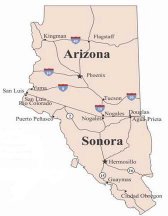North-South
"How the American Political Class Deceives the Public"
One of the best kept secrets in the United States is the degree to which United Nations social and economic policy influences domestic policy. The reason for this is because it is done by the backdoor - through the State Department to the National Security Council/Advisor who coordinates the policy directives with the Cabinet and the agency heads of government. When the UN policies are implemented, the News media - if they provide coverage at all, cover it as if the ideas were homegrown.
The way the system works is that international commissions[1] meets in various locations purporting to gather opinions and ideas on a global problem of interest with representatives of government, private and non-profit sectors.
Society for International Development (History)[2]
"In the 1970s SID examined the growing interdependence among nations and supported calls for more equitable global institutional arrangements. The SID’s North-South Roundtables established in 1979 aimed to bring together key policy makers, academics and analysts to discuss global issues free of the constraints and formalities of the official fora. Proposals resulting from the Roundtables influenced the preparatory processes for the first North-South Summit in Cancun in 1981, contributed to the founding of the South Commission under Julius Nyerere, gave impetus to the idea for a World Summit on Human Development (the Social Summit held in Copenhagen in 1995), and resulted in the idea of producing an annual Human Development Report (taken up by UNDP in the late 1980s)."
They then write a report that is voted on by the United Nations membership and if adopted, it becomes official policy of the UN which means that the UN members are then obligated to act on it despite the disclaimers of sovereignty, local laws and customs, etc.
One such report that was written in 1980 was seminal to the planned break up of the United States as a sovereign nation. The name of the report was ‘North-South: a programme for survival”.[3] It was prepared by the Independent Commission on International Development Issues, chaired by Willy Brandt, former Chancellor of the Federal Republic of Germany.
This political report, prepared by an independent group of international statesmen and leaders headed by Willy Brandt (former Chancellor of the Federal Republic of Germany), discusses the urgent problems of inequality in the world and the failure of its economic system, and proposes suggestions for solving these problems. The title of the report was based on the premise that major international peace cannot be achieved unless the North, which represents the developed countries, and the South, which represents the developing countries, unite together and recognize their mutual interests. Change and reform can only take place when they are supported by the governments and the people of both the North and the South. The North and the South should frankly discuss abuses of power by elites; outburst of fanaticism; the misery of millions of refugees; and other violations of human rights which adversely affect the cause of justice and solidarity everywhere. Tasks for the decades of the '80's and '90's are discussed, and an Emergency Programme for 1980-85 outlined (includes such recommendations as large-scale transfer of resources to developing countries; an international energy strategy; global food program; major reforms in the international economic system). Other recommended solutions include a new approach to international finance and the development of monetary system. The traditional questions of war and peace, and massive expenditures on armaments which take resources away from urgent needs are also examined. The report also calls on all countries of the world to make an imaginative response to the critical problems of the world.
North-South - Mexico
A "mini-summit" was held in Cancun, Mexico in 1981 that was
dubbed the
North-South Summit[5] after the title of the report.
While many of the leftist websites that do mention the
North-South report complain that not much was accomplished
by the report and the summit, that's not true. An
example of the deceptions of the left is apparent in this
2001 report by the Renner Institute[6]:
3) Neoliberal Supply Side overruled Late Keynesianism:
Both Brandt and Kreisky had pursued a different strategy – Brandt when asking for radical disarmament and transformation of the thus saved funds into massive transfers to the “poor”, Kreisky – although due to a sudden illness did not participate in Cancún and turned over his co-chairmanship to the Canadian Prime Minister Pierre Trudeau – advocating a new “Marshall-Plan for the South” ( using a 200 billion US Dollar fund, sponsored by the industrial nations and the OPEC; only 50% should be paid back by the South) . Whereas Reagan and Margaret Thatcher, the Prime Minister from Great Britain pleaded for tax cuts, Brandt had asked for a global tax (carbon tax).
In 2006, the Congressional Research Service produced a report on the U.S. relationship with Mexico titled, "Mexico's Importance and Multiple Relationships with the United States".[7] This report provides the details on the relationship including the North American Development Bank which is used as the funding source for North-South projects. It also describes the North American Free Trade Agreement (NAFTA), the Security and Prosperity Partnership and the trade relationship. On the trade relationship, they give most focus on the aggregate trade volume statistics with a slight mention of the growing trade deficit with Mexico which according to Senator Byron Dorgan went from a $1.5 million surplus before the NAFTA Agreement to a $50 billion trade deficit. This was an indirect transfer of wealth from the American people to the Mexican people meeting the goals of the North-South call for redistribution of wealth. And regardless of how the think tank economists and media spinsters try to spin it, the entire U.S. trade deficit of $ 731,200,000,000- [8] was a transfer of American wealth to the rest of the world and our collapsing economy is proof positive.
In 1981, the
U.S.- Mexico Binational Commission[9] was formed
and the
La Paz Agreement[10] was signed by Reagan in 1983.
Notice how the agreement refers back to the 1972 Stockholm
Agreement which is the way the United Nations agenda is
incorporated into the agreement.
The United States of America and the United Mexican States, RECOGNIZING the importance of a healthful environment to the long-term economic and social well-being of present and future generations of each country as well as of the global community;
RECALLING that the Declaration of the United Nations Conference on the Human Environment, proclaimed in Stockholm in 1972, called upon nations to collaborate to resolve environmental problems of common concern; NOTING previous agreements and programs providing for environmental cooperation between the two countries; BELIEVING that such cooperation is of mutual benefit in coping with similar environmental problems in each country; ACKNOWLEDGING the important work of the International Boundary and Water Commission and the contribution of the agreements concluded between the two countries relating to environmental affairs; REAFFIRMING their political will to further strengthen and demonstrate the importance attached by both Governments to cooperation on environmental protection and in furtherance of the principle of good neighborliness; Have agreed as follows:
ARTICLE 1
The United States of America and the United Mexican States, hereinafter referred to as the Parties, agree to cooperate in the field of environmental protection in the border area on the basis of equality, reciprocity and mutual benefit. The objectives of the present Agreement are to establish the basis for cooperation between the Parties for the protection, improvement and conservation of the environment and the problems which affect it, as well as to agree on necessary measures to prevent and control pollution in the border area, and to provide the framework for development of a system of notification for emergency situations. Such objectives shall be pursued without prejudice to the cooperation which the Parties may agree to undertake outside the border area.
The La Paz agreement was the first concrete step
towards dissolving the United States as a sovereign nation.
The key provisions in this document reveal the framework and
the strategy for expansion of the agreement without further
intervention by the Congress and it turned the border region
into a federally managed area. Initially it concerned
only the environment as it pertains to pollution but the
provisions that allowed expansion have been exercised and
nearly all departments of government are involved including
health, education and emergency management to name a few.
Key Provisions of La Paz Agreement
- Defined the border region as 100 km on either side of the border as an international zone covered by the agreement with provisions to change the agreement by Annex. Articles 3 & 4.
- The EPA Director serves as the national coordinator on the U.S. side and the Secretaria de Desarrollo Urbano y Ecologia on the Mexican side. Additional responsibilities may be agreed to by Annex. Article 8.
- "To implement this Agreement, the Parties SHALL consider and, as appropriate, PURSUE in a coordinated manner National Coordinators will pursue practical, legal, institutional measures..." (Harmonization of laws) Article 6.
- National coordinators may invite participation by representatives of other government agencies (all levels), international representatives, non-governmental organizations and private sector groups. Article 9.
- Implementation subject to funds available but provision was made for "special modality funding as agreed to by the parties". No definition provided on the meaning of "special modality" so it could and probably does mean raising funds from private sources outside the oversight of Congress. Article 14
Border XXI Region
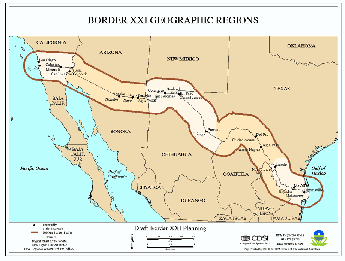
"The
1983 La Paz Agreement to protect and improve the border
environment and Border 2012, a 10-year, binational,
results-oriented environmental program for the U.S.-Mexico
border region. The Border 2012 Program is the latest
multi-year, binational planning effort to be implemented
under the La Paz Agreement and succeeds Border XXI, a
five-year program that ended in 2000."
U.S. State Dept
[11]
This agreement
was written in an open-ended way so that it could be
expanded simply by agreement between the parties. It
created the condition of divided loyalties in the U.S.
government where one section was involved in the
international zone with employees working directly with
Mexican government officials and another strictly domestic -
working on the same issues. The agreement called for the
harmonization of laws between the U.S. and Mexico. And the
linkage between the environment and human rights paved the
way for any type of social spending and programs that the
National Coordinator (EPA) decided up - with agreement by
the Mexican counterpart. A look at the working
groups established as a function of this agreement leads to
the conclusion that this agreement was used as the legal
authority to merge the U.S. and Mexico through harmonization
of laws and integration of the economy.
There are too
many working groups to list but a simple Google search will
provide an overwhelming list on every possible subject one
can imagine.
And the
effective mission of these working groups is to eliminate
American sovereignty and to break up the United States into
"managed" regions making the American system of elected,
representative government a farce.
Office of Economic and Policy Analysis (OEPA)[13]
OEPA reports track progress towards the regional integration of Arizona and Sonora, identify barriers to efficient cross-border trade, and assess the status of infrastructure projects in border communities.
Arizona-Sonora Regional Economic Indicators[14]
Arizona-Sonora Manufacturing Initiative [15]
Declaration of Cooperation on Climate Change [16]
Border Health Collaborative[17]
Partnering
Organizations & Programs [18]
Arizona-Mexico Commission[19]
Arizona-Sonora Economic Region
North-South - Canada
Since Canada is a developed first world country, the means of the merger were a little different but still connected to environmentalism. It's not coincidence that the Council of Great Lakes Governors (CGLG) [20] was formed in 1983 with an environmental mission:
History
The Council of Great Lakes Governors was formed in 1983 by the Governors of Illinois, Indiana, Michigan, Minnesota, Ohio, and Wisconsin to serve as a forum for the development of regional agreements between the Great Lakes Governors on issues of common concern. In 1989, the Council Governors were joined by the Governors of New York and Pennsylvania.
The Beginning of the Council: Environmental Stewardship
The central issue of common concern for all of the Governors was the protection and management of the waters of the Great Lakes. As the primary source of freshwater for the region as well as a superhighway that connected the region to the world, proper management of the lakes was crucial to the health of the residents of the Great Lakes region as well as the continued growth of the region’s economy. Consequently, coordinating Great Lakes regional water policy was the original impetus for the creation of the Council. As a result of the first Council projects, the Governors joined with the Premiers of Ontario and Quebec and signed the Great Lakes Charter of 1985, a good faith agreement to collectively manage Great Lakes water uses to make certain that the levels and flows of Great Lakes water was not unduly disrupted.
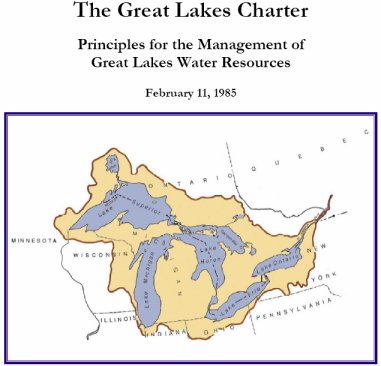
Great Lakes Charter of 1985[21]
In 1986,
Reagan signed the Transboundry Movement of Hazardous Waste
agreement with Canada. A copy of the agreement was
found on the website of Senator
Debbie Stabenow of Michigan.[22] Notice that again this
agreement references back to the 1972 Stockholm Agreement.
Also notice that the agreement was signed by the EPA
Administrator, Lee Thomas.
Agreement Between the Government of Canada and the Government of the United States of America Concerning the Transboundary Movement of Hazardous Waste
The Government of Canada (Canada), and the Government of the United States of America (the United States), hereinafter called "The Parties":
RECOGNIZING that severe health and environmental damage may result from the improper treatment, storage, and disposal of hazardous waste;
SEEKING to ensure that the treatment, storage, and disposal of hazardous waste are conducted so as to reduce the risks to public health, property and environmental quality;
RECOGNIZING that the close trading relationship and the long common border between the United States and Canada engender opportunities for a generator of hazardous waste to benefit from using the nearest appropriate disposal facility, which may involve the transboundary shipment of hazardous waste;
BELIEVING that a bilateral agreement is needed to facilitate the control of transboundary shipments of hazardous waste between the United States and Canada;
REAFFIRMING Principle 21 of the 1972 Declaration of the United Nations Conference on the Human Environment, adopted at Stockholm, which asserts that states have, in accordance with the Charter of the United Nations and the principles of international law, the sovereign right to exploit their own resources pursuant to their own environmental policies and the responsibility to ensure that activities within their jurisdiction or control do not cause damage to the environment of other states or of areas beyond the limits of national jurisdiction;
TAKING into account OECD Council Decisions and Recommendations on transfrontier movements of hazardous wastes, the UNEP Cairo Guidelines and Principles for the Environmentally Sound Management of Hazardous Waste, and resolutions of the London Dumping Convention,
In 1986, negotiations began for the
Canada-US Free Trade Agreement (CUSFTA).[23] It was
signed in 1988 and became effective in 1989. The
government websites talk about economic integration - which
translates to erasure of our borders with Canada. The
U.S.-Canadian working groups perform the same functions as
the U.S.-Mexico working groups - harmonization of laws,
coordination of policy, "management" replacing elected,
representative government.
And just like the U.S. Mexican border states, what began ostensibly to address environmental issues, the mission expanded to cross-border economic integration and development. Continuing with the CGLG History Page:[24]
The Council Continues to Grow: Economic Development
In the late 1980’s, the effectiveness of the Council as a tool for addressing issues of collective concern became more apparent and the Governors recognized that the health of the environment and the health of the economy were closely related. They further recognized that these collective concerns could be addressed not only through agreements between the States, but also through cooperative projects that conclude with a new regional approach to address an issue of concern.
The Governors combined their early economic activities for improving the regional economy into their 1988 Economic Development Agreement. This agreement, formulated during the chairmanship of Ohio Governor Richard Celeste, outlined basic principles for the development of the Great Lakes region and had the benefit of all of its citizens at its core. This Economic Development Agreement marked the change in the Council’s orientation from an agreement-based to a project-based organization.
...The Council’s mission continues to evolve under the Chairmanship of Governor Jim Doyle of Wisconsin. The Governors are working with their respective legislatures to turn the Compact into law, while the Premiers are also taking steps to implement the promises made in the Agreement into law.
But the Council of Great Lakes Governors won't be the first to put their international regional compact into law. The Pacific NorthWest Economic Region Council (PNWER) was the first:
The Pacific NorthWest Economic Region (PNWER) [25] is the only regional planning and facilitation organization set up in statute by the border states and provinces to deal with transboundary policy and planning in the Pacific Northwest.
Idaho Ref: Idaho Statutes Title 67, Chapter 78, 67-7803 [26]
The PNWER was formed in 1991 and their 2005 Annual Report[27] listed the functional working groups for the region:
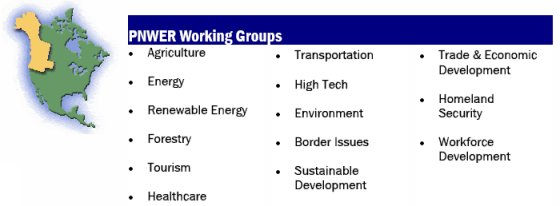
The following page was printed from a World Bank policy research paper[28]on the impact of regional trade agreements. There is no secret among political elites regarding the real purpose behind the regional agreements and trade policy. It's only the American people who don't know that these agreements were written for global redistribution of wealth - with the objective to take from them to give to others exactly as the Social Democrat (socialist) Willy Brandt intended when his commission wrote the North-South report.
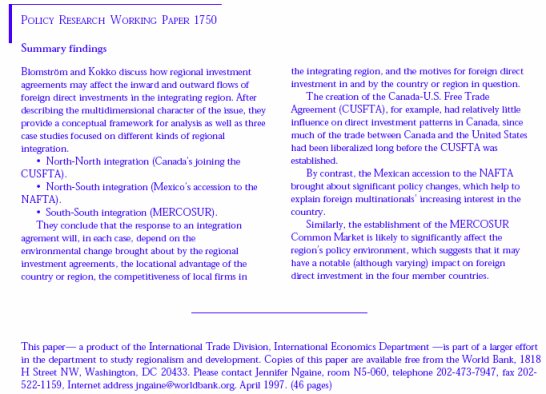
Regionalization as it is being implemented in the United
States is leading to the break up of the United States just
as Igor Panarin predicted and Andrew Osborne wrote about in
his feature titled, "As
if Things Weren't Bad Enough, Russian Professor Predicts End
of U.S." [29] Panarin didn't need a crystal ball.
He just needed to follow the UN Agenda, the international
agreements the U.S. has signed and the implementation of
them in the United States just as I did above.
It's not at all surprising that the Wall Street Journal
would attempt to associate the information on the planned
disintegration of the United States as a sovereign nation
with Russian propaganda. Osborne's piece
is itself propaganda. The Wall Street Journal has been
complicit all the way in the betrayal of the American people
by the selection of what they publish and the "experts" they
choose to quote and the experts they choose to poke fun at
as in the case of Igor Panarin.
The ironic
twist is that when I wrote to Mr. Osborne to ask if he was a
member of the CFR and if the purpose of the piece was to
introduce the topic... create the buzz that would open the
subject for public discussion, he wrote back saying that "We
wanted to show how people here are being encouraged to view
the U.S. -- for a whole host of internal reasons, one of
which – according to local experts – is a sharp rise in
politically-motivated anti-Americanism." I don't
know how to take that - other than apparently it is Wall
Street's point of view that it is anti-American to tell the
truth - to expose the agenda of the American political elite
using information that is freely available to the public.
But then again, it makes perfect sense in the Orwellian
world of 21st century America where we are supposed to
believe the illusions they build and present as reality
contrary to what our own lying eyes can see.
"Divide the world into regional groups as a transitional state to world government. Populations will more readily abandon their national loyalty to a vague regional loyalty than they will for a world authority. Later the regions can be brought together all the way into a single world dictator." Stalin, 1942
Vicky
Davis,
January 1, 2009
__________________
1] Frederic Lapeyre, "The
Outcome and Impact of the Main International Commissions on
Development Issues", Working Paper No. 30, May 2004,
International Labor Office, Geneva
http://www.ilo.org/wcmsp5/groups/public/---dgreports/---integration/documents/publication/wcms_079106.pdf
recovered
PDF 11/29/2010
2] Society for International Development website,
History Page, January 1, 2009,
http://www.sidint.org/Content.aspx?IdArea=14&IdCat=51&Type=C
recovered
PDF 11/29/10
3] Report of the International Commission on
Development Issues, Chairman Willy Brandt,
"North-South: A Programme for Survival", (Brandt Report),
posted on Global Marshall Plan website,
http://www.globalmarshallplan.org/infocenter/texts/the_brandt_report/index_eng.html
4]
Abstract, North-South: a programme for survival: report of
the Independent Commission on International Development
Issues., Brandt W
Source: Cambridge, Massachussetts, MIT Press, 1980. 304 p.,
Johns Hopkins School of Public Health Document Library,
http://db.jhuccp.org/ics-wpd/exec/icswppro.dll?BU=http://db.jhuccp.org/ics-wpd/exec/icswppro.dll&QF0=DocNo&QI0=800829&TN=Popline&AC=QBE_QUERY&MR=30%25DL=1&&RL=1&&RF=LongRecordDisplay&DF=LongRecordDisplay
5] CIA National Foreign Assessment Center, Memorandum,
January 12, 1981, "Prospects for a North-South Summit on
International Economic Development and Cooperation,
http://www.foia.cia.gov/browse_docs.asp?doc_no=0000279418
6] Renner Institute, International Conference,
'Transcending Borders - Global Management Since The
Seventies', Oliver Rathkolb, "The North-South Conflict as
True Global Conflict", Page 3, Berlin, November 14-15, 2001.
http://www.renner-institut.at/download/texte/rathkolb_e.pdf
7] Congressional Research Service, K. Larry
Storrs, "Mexico's Importance and Multiple Relationships with
the United States", RL 33244, January 18, 2006
http://fpc.state.gov/documents/organization/60778.pdf
8] CIA World Fact Book, Rank Order - Current
Account Balance, 2007 est,
https://www.cia.gov/library/publications/the-world-factbook/rankorder/2187rank.html
9] U.S. State Department website, U.S. - Mexico
Binational Commission,
http://www.state.gov/p/wha/ci/mx/c10787.htm
10] Joint Advisory Committee for the Improvement of Air
Quality Paso Del Norte website, La Paz Agreement Between the
United States of America and the United Mexican States for
Cooperation for the Protection and Improvement in the Border
Area,
http://www.jac-ccc.org/Agreement.htm
11] U.S. State Department website, Mexico Background Notes,
Border and Environmental Affairs,
http://www.state.gov/r/pa/ei/bgn/35749.htm
12] Environmental Protection Agency website, US-Mexico
Border 2012 Program, U.S. - Mexico Arizona-Sonora Regional
Workgroup,
http://www.epa.gov/border2012/regional/workgroup-az.html
13] University of Arizona, Office of Economic Policy
Analysis (OEPA),
http://www.oepa.arizona.edu/
14] University of Arizona, OEPA, Vera Pavlakoich-Kochi, Ph.D,
and Juliet King, Ph.D, 2006 Arizona-Sonora Regional Economic
Indicators Report, "Moving Towards A Globally Competitive
Regional Economy",
http://www.oepa.arizona.edu/Lib/Media/Docs/Final%20Arizona-Sonora%20Reg%20Ind%20version%20Nov%201.pdf
15] Arizona Department of Commerce, Arizona-Sonora
Manufacturing Initiative LLC, Wendy Vittori, Pres.
"Opportunities for Knowledge Based Manufacturing in the
Arizona-Sonora Binational Region, September 2008,
http://www.azcommerce.com/doclib/commune/rdc/rdc08/bi-national.pdf
16] Declaration of Cooperation, Government of the state of
Sonora through the Secretariat of Urban Infrastructure and
Ecology with the government of the state of Arizona through
the Arizona Department of Environmental Quality to Establish
the Arizona-Sonora Climate Change Initiative, June 18, 2005,
http://www.azclimatechange.gov/initiatives/download/signed_agreement.pdf
17] Arizona Department of Health Services, Division of
Public Health, Office of Border Health, Early Warning
Infectious Disease Surveillance (EWIDS) trinational program,
binational cooperation, Arizona-Sonora.
http://www.azdhs.gov/phs/borderhealth/ewids.htm
18] Arizona Department of Environmental Quality, Office of
Border Environmental Protection, Partnering Organizations
and Programs,
http://www.azdeq.gov/obep/partner.html
19] Arizona-Mexico Commission, AMC Fact Sheet, 2006
Accomplishments,
http://www.azmc.org/pdf/2006_amc_accomplishments.pdf
20] Council of Great Lakes Governors (CGLG) website, History
Page,
http://www.cglg.org/Overview/History.asp
21] Council of Great Lakes Governors, "The Great Lakes
Charter", February 1985,
http://www.cglg.org/projects/water/docs/GreatLakesCharter.pdf
22] Senator Debbie Stabenow of Michigan, Congressional
website, "Agreement Between the Government of Canada and the
Government of the United States of America Concerning the
Transboundary Movement of Hazardous Waste", October 1986,
http://stabenow.senate.gov/stoptrash/transboundary.htm
23] Government of Canada website, Canada-U.S. Free Trade
Agreement, "Eliminating Barriers to Trade",
http://www.canadianeconomy.gc.ca/English/economy/1989economic.html
24] Same as Footnote 20
25] Pacific NorthWest Economic Region (PNWER) Council
website,
http://www.pnwer.org/
26] Channeling Reality website, Idaho State Statutes, text
of Title 67, Chapter 78, Sections 7801, 7802, 7803, Pacific
NorthWest Economic Region,
http://www.channelingreality.com/NAU/Regionalism/PNWER_idaho_statutes.htm
27] PNWER 2005 Annual Report, Channeling Reality website,
retrieved from Internet Archive,
http://www.channelingreality.com/NAU/Regionalism/PNWER_2005_Annual_Report.pdf
28] Worldbank Policy
Research Paper, International Economics Department,
International Trade Division, Magnus Blomstrom and Ari Kokko,
"Regional Integration and Foreign Direct Investment", April
1997,
http://www.worldbank.org/html/dec/Publications/Workpapers/WPS1700series/wps1750/wps1750.pdf
29] Wall Street Journal online, Andrew Osborne, "As If
Things Weren't Bad Enough, Russian Professor Predicts End of
U.S.", December 29, 2008,
http://online.wsj.com/article/SB123051100709638419.html
All website references were active on January 1, 2009
